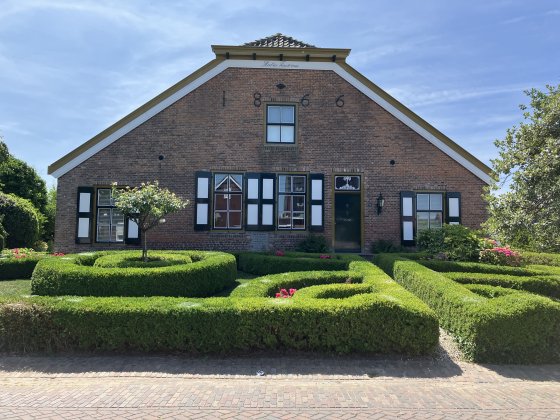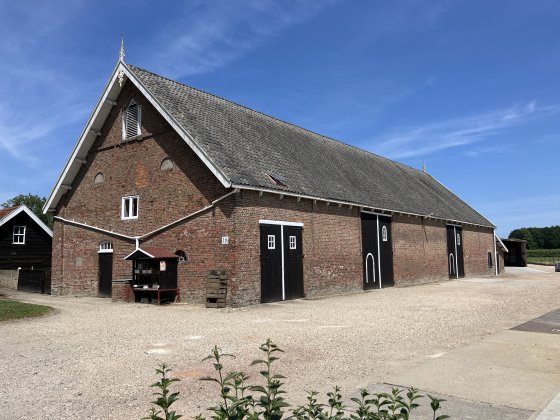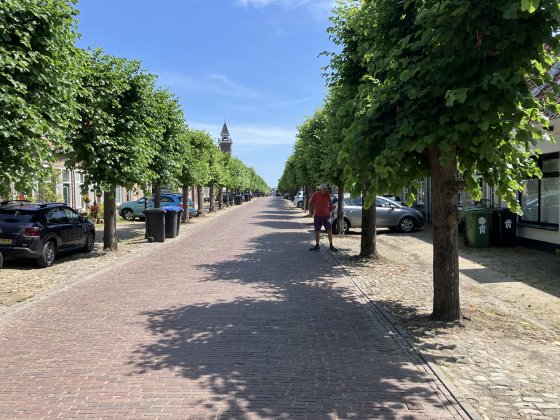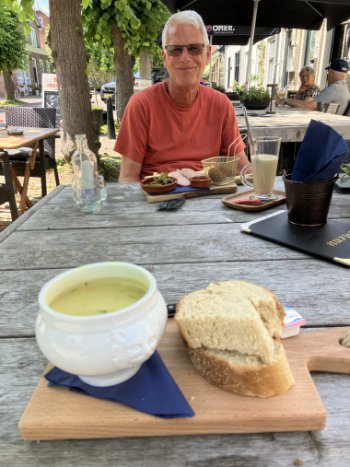 Typical Wemeldinge House with Manicured Garden |
Once my laundry had been sorted, and a sheet strung across the cockpit for shade, I took Rex on a hike past the windmills and skirting the south of town towards the Vliedberg and church. Substantial houses with large, lush gardens lined this route. On our left we passed a large sports complex comprising football fields, tennis courts and a football stadium - not bad for a small town.
Eventually we reached a large pond in front of the church. Many water lillies lounged across the water, small fish darted about amongst the reeds and lillies, and the air above them continuously burst with flashes of blue as a myriad blue dragonflies patrolled the surface. At one time cows would have been seen walking down a slope into the pond for a refreshing drink. It was 25 degrees and we could have done with a dip too.
 Wemeldinge Farm Near the Church |
The original village was built around three artificial hills, so-called 'vliedbergen'. These hills were built in the 13th century to live on, sometimes with a stronghold, to protect the people from enemy attacks. Apparently, near the church, there are two of these hills. The church itself was built on one of them, and the other is nearby in a private garden. We had trudged across town to see the famed Vliedberg of Wemeldinge, at 12m high, the highest vliedberg of Zeeland. We couldn't even see it since it was buried under a clump of trees. The third was levelled in the 19th century to raise the fields. What is special about Wemeldinge is that the church is in fact located outside of the village. After the great flood of 1134, the people moved close to the new dyke, which is presently Dorpsstraat. In the 19th century the village expanded in the direction of the canal, because that was where the jobs were. Interestingly, as a result, the oldest part of the village ultimately ended up on the outskirts.
 Dorpsstraat |
 Mustard Soup at Cafe de Zeevonk |
 Evening Meal Drinks |
"I heard you talking on the street," was her quick response, presented with a pleasant laugh. Rex devoured a huge plate of sausage meats, cheeses, gherkins and bitterballen. I had mustard soup which had drastic consequences later in the day.
The town square was at the end of the street, nothing to write home about: a Spar, garage and school. Rex was getting agitated, there was nowhere he could buy cigarettes, not even the Spar. For variety, I dragged Rex over to the sea wall Promenade, and then back to home base.
Evening was spent at a pleasant restaurant on the Binnendijk, just by the steps up to the Promenade. The food was good, so good that it inspired Rex to try and teach me how to roll my Rs (he reckons it is essential in the Dutch language, though he makes no effort to learn it). This ended in failure. Behind Rex, a Dutch chap had been seated, and he walked over to us after observing Rex's failed language lesson, and rattled off a Dutch tongue twister full of Rs. I gave up.
